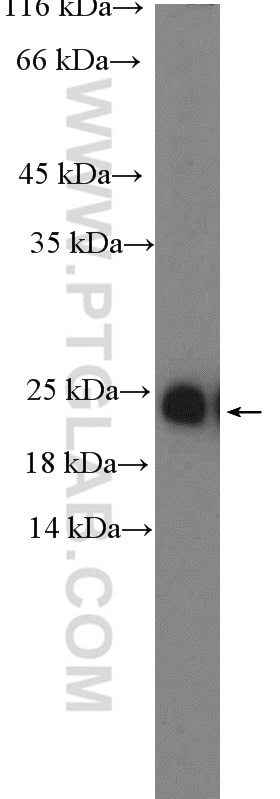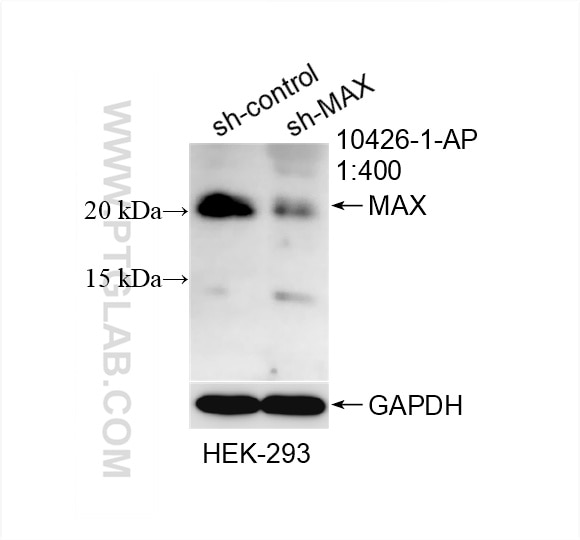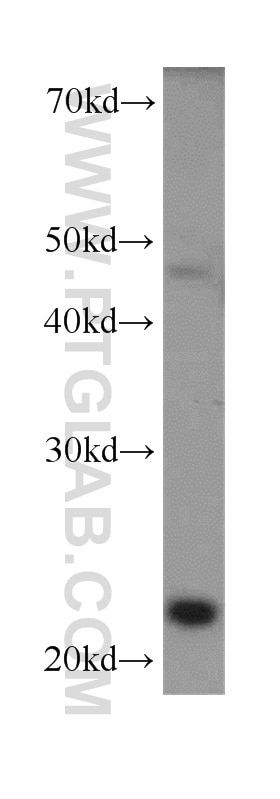- Phare
- Validé par KD/KO
Anticorps Polyclonal de lapin anti-MAX
MAX Polyclonal Antibody for WB, ELISA
Hôte / Isotype
Lapin / IgG
Réactivité testée
Humain et plus (1)
Applications
WB, IHC, IF, IP, chIP, ELISA
Conjugaison
Non conjugué
N° de cat : 10426-1-AP
Synonymes
Galerie de données de validation
Applications testées
| Résultats positifs en WB | cellules HEK-293, cellules PC-3 |
Dilution recommandée
| Application | Dilution |
|---|---|
| Western Blot (WB) | WB : 1:500-1:1000 |
| It is recommended that this reagent should be titrated in each testing system to obtain optimal results. | |
| Sample-dependent, check data in validation data gallery | |
Applications publiées
| KD/KO | See 1 publications below |
| WB | See 8 publications below |
| IHC | See 2 publications below |
| IF | See 2 publications below |
| IP | See 1 publications below |
| ChIP | See 4 publications below |
Informations sur le produit
10426-1-AP cible MAX dans les applications de WB, IHC, IF, IP, chIP, ELISA et montre une réactivité avec des échantillons Humain
| Réactivité | Humain |
| Réactivité citée | Humain, souris |
| Hôte / Isotype | Lapin / IgG |
| Clonalité | Polyclonal |
| Type | Anticorps |
| Immunogène | MAX Protéine recombinante Ag0680 |
| Nom complet | MYC associated factor X |
| Masse moléculaire calculée | 18 kDa |
| Poids moléculaire observé | 22 kDa |
| Numéro d’acquisition GenBank | BC003525 |
| Symbole du gène | MAX |
| Identification du gène (NCBI) | 4149 |
| Conjugaison | Non conjugué |
| Forme | Liquide |
| Méthode de purification | Purification par affinité contre l'antigène |
| Tampon de stockage | PBS with 0.02% sodium azide and 50% glycerol |
| Conditions de stockage | Stocker à -20°C. Stable pendant un an après l'expédition. L'aliquotage n'est pas nécessaire pour le stockage à -20oC Les 20ul contiennent 0,1% de BSA. |
Informations générales
Max, a member of MAX family, contains a basic helix-loop-helix (bHLH) domain, is a transcription regulator. MAX can form a sequence-specific DNA-binding protein complex with MYC or MAD which recognizes the core sequence 5'-CAC[GA]TG-3'. The MYC-MAX complex is a transcriptional activator, while the MAD-MAX complex is a repressor. MAX could dimerizated with another bHLH protein to form a heterodimer, such MYC or MAD. Thus bands recognized by this antibody much larger than predicted.
Protocole
| Product Specific Protocols | |
|---|---|
| WB protocol for MAX antibody 10426-1-AP | Download protocol |
| Standard Protocols | |
|---|---|
| Click here to view our Standard Protocols |
Publications
| Species | Application | Title |
|---|---|---|
Cancer Cell MAX Functions as a Tumor Suppressor and Rewires Metabolism in Small Cell Lung Cancer.
| ||
Sci Adv A MYC inhibitor selectively alters the MYC and MAX cistromes and modulates the epigenomic landscape to regulate target gene expression. | ||
Nat Commun PCGF6 controls neuroectoderm specification of human pluripotent stem cells by activating SOX2 expression. | ||
Elife Loss of MGA repression mediated by an atypical polycomb complex promotes tumor progression and invasiveness. | ||
Cell Commun Signal Novel dual-targeting c-Myc inhibitor D347-2761 represses myeloma growth via blocking c-Myc/Max heterodimerization and disturbing its stability. | ||
J Biol Chem Role for carbohydrate response element-binding protein (ChREBP) in high glucose-mediated repression of long noncoding RNA Tug1. |





